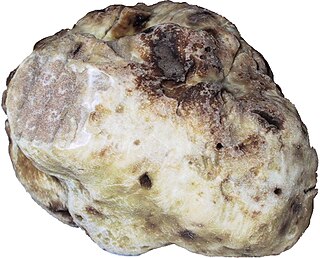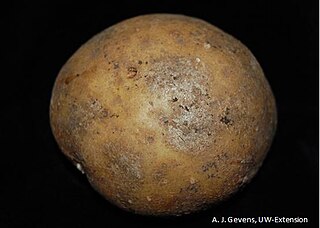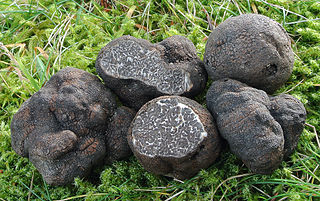
A truffle is the fruiting body of a subterranean ascomycete fungus, one of the species of the genus Tuber. More than one hundred other genera of fungi are classified as truffles including Geopora, Peziza, Choiromyces, and Leucangium. These genera belong to the class Pezizomycetes and the Pezizales order. Several truffle-like basidiomycetes are excluded from Pezizales, including Rhizopogon and Glomus. Truffles are ectomycorrhizal fungi, so they are found in close association with tree roots. Spore dispersal is accomplished through fungivores, animals that eat fungi. These fungi have ecological roles in nutrient cycling and drought tolerance.

Tuber magnatum, the white truffle, is a species of truffle in the order Pezizales and family Tuberaceae. It is found in southern Europe, the Balkans and Thailand.

Stenotrophomonas is a genus of Gram-negative bacteria, comprising at least ten species. The main reservoirs of Stenotrophomonas are soil and plants. Stenotrophomonas species range from common soil organisms to opportunistic human pathogens ; the molecular taxonomy of the genus is still somewhat unclear.

Lake Cadagno is a meromictic lake in the Piora valley, Switzerland. As one of a few meromictic lakes in Europe, it is the object of numerous scientific studies. The Piora valley - located in the Saint-Gotthard Massif in the Southern part of Switzerland near Airolo at an altitude of 1921 m above sea level - is a landlocked alpine valley whose scientific value has been recognized for more than two centuries. In the past, the lake was used as a reservoir.

Helminthosporium solani is a fungal plant pathogen responsible for the plant disease known as silver scurf. Silver scurf is a blemish disease, meaning the effect it has on tubers is mostly cosmetic and affects "fresh market, processing and seed tuber potatoes." There are some reports of it affecting development, meaning growth and tuber yield. This is caused by light brown lesions, which in turn change the permeability of tuber skin and then it causes tuber shrinkage and water loss, which finally causes weight loss. The disease has become economically important because silver scurf affected potatoes for processing and direct consumption have been rejected by the industry. The disease cycle can be divided into two stages: field and storage. It is mainly a seed borne disease and the primary source of inoculum is mainly infected potato seed tubers. Symptoms develop and worsen in storage because the conditions are conducive to sporulation. The ideal conditions for the spread of this disease are high temperatures and high humidity. There are also many cultural practices that favor spread and development. There are multiple ways to help control the disease.

Quercus rotundifolia, the holm oak or ballota oak, is an evergreen oak native to the western Mediterranean region, with the majority on the Iberian Peninsula and minor populations in Northwest Africa. The species was first described by Jean-Baptiste Lamarck in 1785. It is the typical species of the Iberian dehesa or montado, where its sweet-astringent acorns are a source of food for livestock, particularly the Iberian pig. Its acorns have been used for human nourishment since the Neolithic era. It is placed in section Ilex. Some authors described it as a subspecies of Quercus ilex.

Tuber oregonense, commonly known as the Oregon white truffle, is a species of edible truffle in the genus Tuber. Described as new to science in 2010, the North American species is found on the western coast of the United States, from northern California to southern British Columbia west of the Cascade Range. A mycorrhizal fungus, it grows in a symbiotic association with Douglas fir. It overlaps in distribution with the closely related T. gibbosum, but they have different growing seasons: T. oregonense typically appears from October through March, while T. gibbosum grows from January to June. The fruit bodies of the fungus are roughly spherical to irregular in shape, and resemble small potatoes up to 5 cm (2 in) in diameter. Inside the truffle is the gleba, which is initially white before it becomes a marbled tan color. The large, often thick-walled, and strongly ornamented spores are produced in large spherical asci. The truffle is highly prized for its taste and aroma. Some individuals have claimed success in cultivating the truffles in Christmas tree farms.

Tuber melanosporum, called the black truffle,Périgord truffle or French black truffle, is a species of truffle native to Southern Europe. It is one of the most expensive edible fungi in the world. In 2013, the truffle cost between 1,000 and 2,000 euros per kilogram.
Borrelia tanukii is a spirochete bacterium first isolated from specimens of Ixodes tanuki, hence its name.
Bradyrhizobium yuanmingense is a species of legume-root nodulating, endosymbiont nitrogen-fixing bacterium, associated with Lespedeza and Vigna species. Its type strain is CCBAU 10071(T).
Thermodesulforhabdus norvegica is a species of thermophilic sulfate-reducing bacteria, the type and only species of its genus. It is gram-negative, acetate-oxidizing, with type strain A8444.

Tuber macrosporum, commonly known as the smooth black truffle, is a species of edible truffle in the family Tuberaceae. Found in Europe, and common in central Italy, the truffle was described as new to science by Italian mycologist Carlo Vittadini in 1831. The truffles are roughly spherical to irregular in shape, and typically measure 0.5 to 2 centimetres in diameter. The surface color ranges from reddish brown to rust to blackish. Warts on the fruit body surface are low, so that the truffle appears fairly smooth. The truffle flesh is purplish brown to grey-brown with thin white veins. It has an intense garlic-like odor similar to the Italian white truffle. Host plants of T. macrosporum include poplars, hazel, linden, and oaks.
Trichoderma theobromicola is a species of endophytic fungus in the family Hypocreaceae. It was first isolated from the trunk of a healthy cacao tree in Amazonian Peru. It produces a volatile antibiotic that inhibits development of M. roreri.
Trichoderma paucisporum is a species of endophytic fungus in the family Hypocreaceae. It was first isolated in Ecuador from cacao pods infected with frosty pod rot, Moniliophthora roreri. It produces a volatile antibiotic that inhibits development of M. roreri.
Phytophthora polonica is a non-papillate homothallic plant pathogen known to infect alder species.

Streptomyces netropsis is a bacterium species from the genus of Streptomyces. Streptomyces netropsis produces the antibiotics netropsin and distamycin A and the antifungal polyene mycoheptin.

Tuber borchii, known as the whitish truffle or bianchetto truffle, is a small, common species of edible truffle excellent for use in cuisine.
Myroides profundi is a Gram-negative, aerobic and non-motile bacterium from the genus of Myroides which has been isolated from deep-sea sediments from the southern Okinawa Trough.
Vibrio azureus is a gram negative, oxidase and catalase positive marine bacterium. It is commonly found in marine environments and was isolated from marine sponges of the Saint Martin's Island area of the Bay of Bengal, Bangladesh. Colonies are medium-sized, round and whitish; individual bacteria have a curved rod shape and are motile. It has been observed to emit a blue light using an additional blue-fluorescent protein.
Alkalihalobacillus alkalinitrilicus is a bacterium from the genus of Alkalihalobacillus.











